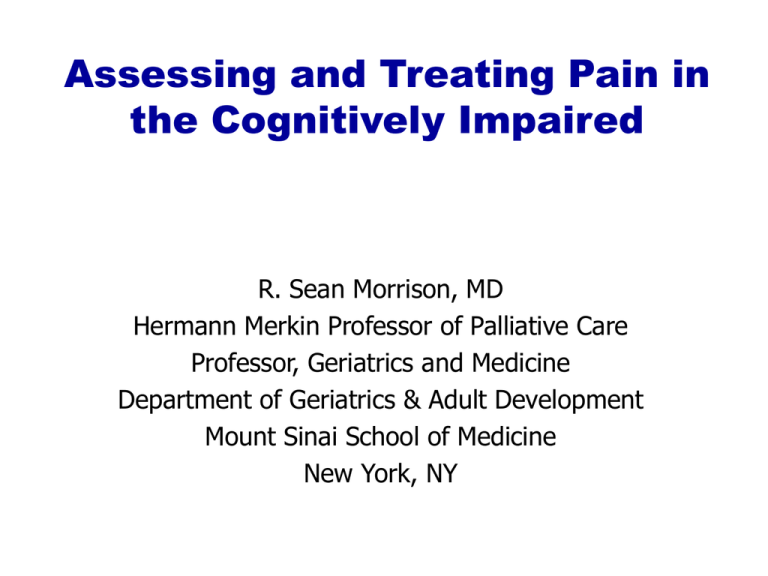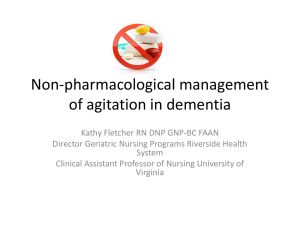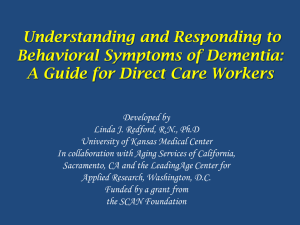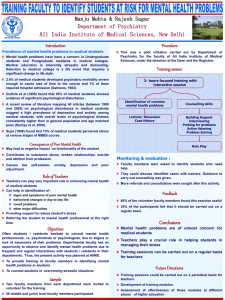Asking for money: One person`s view
advertisement

Assessing and Treating Pain in the Cognitively Impaired R. Sean Morrison, MD Hermann Merkin Professor of Palliative Care Professor, Geriatrics and Medicine Department of Geriatrics & Adult Development Mount Sinai School of Medicine New York, NY Acknowledgements Mary Ersek, PhD, RN Swedish Medical Center, Seattle, Washington. mary.ersek@swedish.org Acknowledgements E L N E C Geriatric Curriculum End-of-Life Nursing Education Consortium • “To provide nurses at all levels of preparation the knowledge to provide competent, compassionate palliative care to patients in a variety of clinical settings” • ELNEC-Geriatrics: focused on licensed nursing staff & CNAs working in long-term care settings • Next ELNEC-Geriatric training: Pasadena, CA, September 12— 14, 2007 • For more information: http://www.aacn.nche.edu/ELNEC/ Definitions of Pain • “An unpleasant sensory and emotional experience associated with actual or potential tissue damage” IASP, 1979 • “Pain is whatever the person says it is…” McCaffery & Pasero, 1999 Pain in Older Adults • 25 – 56% community-dwelling elders Helme & Gibson, 2001 • 45 – 85% nursing home residents AGS, 2002 • 1/3 cancer pts receiving treatment and 2/3 with advanced cancer APS, 2003 • 50% of hospitalized pts in last 3 days of life SUPPORT, 1995 Acute and Chronic Pain ACUTE • Sudden onset, in response to illness or injury • Usually decreases over time as healing occurs; self-limiting • Goal: eliminate pain by treating cause • Physical signs: “fight or flight” • Behavioral signs CHRONIC (PERSISTENT) • Insidious onset, or follows acute • Lasts beyond expected healing period or associated with a chronic condition • Goal: maintain function & quality of life • Behavioral signs Major Categories of Pain Nociceptive Sources: organs, bone, joint, muscle, skin, connective tissue Examples: arthritis, tumors, gall stones Character: dull, aching, pressure, tender Responds to traditional pain medicines & therapies Neuropathic Source: peripheral nerve or CNS pathology Examples: postherpetic neuralgia, diabetic neuropathy Character: shooting, burning, stabbing Requires different types of medications than nociceptive pain Most Common Types of Persistent Pain in Older Adults • Musculoskeletal (e.g., low back pain, osteoarthritis) • Neuropathies (e.g., diabetic neuropathy, post-herpetic neuralgia) • Cancer AGS, 2002 Nonverbal residents • Advanced dementia • Progressive neurological disease • Post CVA • Imminently dying • Developmentally disabled • Delirium A b ility to se lf-re p o rt p a in Pain Self-Report and Cognitive Impairment in Dementia Patients Nonverbal C o g n itive im p a irm e n t Is pain processed and perceived differently by people with dementia? • Tolerance to acute pain possibly increases but pain threshold does not appear to change (Benedetti et al, 1999;2004) • Dementia may blunt autonomic nervous system’s response to acute pain (Rainero et al, 2000) • Cognitive impairment may ↓ perceived analgesic effectiveness (Benedetti et al, 2006) Can Residents with Cognitive Impairment (CI) Give Reliable Pain Reports? • CI residents slightly underreport pain, but their reports are valid (Parmelee et al., 1993) • 83% of residents with mild to moderate CI could reliably complete at least one pain scale (Ferrell et al., 1995) • 73% of post-op patients with moderate CI were able to complete a 4-point verbal descriptor scale (Feldt et al., 1998) Cognitive Impairment & Pain Management: Nursing Homes • Pain is documented less frequently for CI residents, even with similar numbers of painful diagnoses as less impaired residents (Sengstaken & King, 1993) • Less analgesic is prescribed/administered for CI residents, despite similar numbers of painful diagnoses (Horgas & Tsai, 1998) • Approximately ¼ of demented residents who were identified as having pain were receiving any analgesic therapy (Scherder et al, 1999; Bernabei et al, 1998; Won et al, 1999) Outcomes of Unrelieved Pain • • • • • • • • Unnecessary suffering Depression and anxiety Impaired ambulation, gait disturbance Sleep disturbances Decreased socialization Increased healthcare utilization Increased agitation and resistance to care Impaired cognition Pain and Delirium • Risk factors for delirium among older adults hospitalized with hip fracture • Cognitive impairment (RR: 3.6; 95% CI 1.6—7.2) • Received < 10 mg parenteral MS equivalents (RR: 5.4; 95% CI 2.4—12.3) • In cognitively intact patients, severe pain was associated with 9 times the risk of delirium —Morrison et al, 2003 Conceptual Model for Pain Assessment in Noncommunicative Persons with Dementia Snow et al, 2004 ASPMN Position Statement/Guideline • All persons deserve prompt recognition and treatment of pain even when they cannot express their pain verbally • Establish a pain assessment procedure • Use Hierarchy of Pain Assessment Techniques • “Assume pain is present” • Use empirical trials • Re-assess and document www.aspmn.org/Organization/position_papers.htm Hierarchy of Data Sources • Resident report (if possible) • • • • • Prior pain history Painful diagnoses Behavioral indicators Observer assessment Response to empirical therapy Don’t make assumptions based on medical diagnoses or scores on dementia rating scales • Focus on present pain • Find a scale that works and use it consistently • Use verbal reports and observations • Assess reliability by asking about pain at different time (when pain is expected to be more severe, e.g., during movement) Painful Diagnoses • • • • • • • • Degenerative Joint Disease Degenerative Disc Disease Spinal Stenosis Osteoporosis/Compression Fractures Diabetes Cancer Herpes Zoster Pressure Ulcers/wounds Causes of Physical Pain in Residents with Dementia • Constipation or diarrhea • Lodged food particles • Contractures • Pressure ulcers • UTI Volicer & Hurley, 1999 Behavioral/Observational Cues • • • • • • • • • • • Grimacing or wincing Bracing Guarding Rubbing Changes in activity level Sleeplessness, restlessness Resistance to movement Withdrawal/apathy Increased agitation, anger, etc. Decreased appetite Vocalizations Pain Behavior Assessment Tools • Checklist for Nonverbal Pain Indicators (CNPI) (Feldt, 2000) • NOPAIN (Snow et al, 2004) • PAIN-AD (Warden et al, 2003) • Pain Assessment Scale for Seniors with Severe Dementia (PACSLAC) (Fuchs-Lacelle & Hadjistavropoulos, 2004) • Also see: Herr, Decker, & Bjoro (2004). State of the Art Review of Tools for Assessment of Pain in Nonverbal Older Adults. • Available at: http://www.cityofhope.org/prc/elderly.asp Pain Behavior Assessment Tools • Checklist for Nonverbal Pain Indicators (CNPI)…Feldt, 2000 • NOPAIN…Snow et al, 2003 • PAIN-AD… Warden et al, 2004 • Pain Assessment Scale for Seniors with Severe Dementia (PACSLAC)…Fuchs-Lacelle & Hadjistavropoulos, 2004 • State of the Art Review of Tools for Assessment of Pain in Nonverbal Older Adults • Available at: http://www.cityofhope.org/prc/elderly.asp Agitation • Pittsburgh Agitation Scale – Resident Case Manager Assessment • Evaluates: aberrant vocalization, motor agitation, aggressiveness, resistance to care • 0–16 with higher scores indicating greater agitation Minimize reliance on physical signs • ANS stimulation: ↑ BP, ↑ HR, ↑RR, diaphoresis • Blunted in elderly, esp. cognitively impaired • Only valid for acute pain Caregiver Report Pay particular attention to changes from normal behaviors Empirical Trials in Nonverbal residents Try pain medicine Behaviors suggest it could be pain Behaviors decrease It’s probably pain! A sse ss fo r p o ssib le p a in b e h a vio rs D o cu m e n t a sse ssm e n t a n d R x re sp o n se E n su re b a sic co m fo rt n e e d s a re m e t R e -e va lu a te p a in b e h a vio rs E va lu a te a n d tre a t n e w a cu te p ro b le m s (e .g ., U T I) A d m in iste r a n a lg e sic Comfort Needs Glasses? Dentures? Hearing aid? Environmental stressors? Toileting? Lonely? Fearful? Over-stimulated? Acute or New Pain Fall? Infection? Impaction? ??? Evidence for attempting empirical analgesic trial • Regular analgesic therapy increased social engagement in NH residents (Chibnall et al, 2005) • Use of standardized assessment and treatment protocol significantly decreased discomfort among demented NH residents (Kovach et al, 1999) • Evaluation of 650 mg TID APAP: 63% decrease in negative behaviors, 75% psychotropics discontinued (Douzjian et al, 1998) Administer Analgesic • 650 – 1000 mg acetaminophen every 4 hours • 2.5 hydrocodone/500 APAP or 2.5—5.0 oxycodone every 4 hours • Include nondrug measures Communication and documentation is critical in successful assessment and treatment of pain in nonverbal residents









